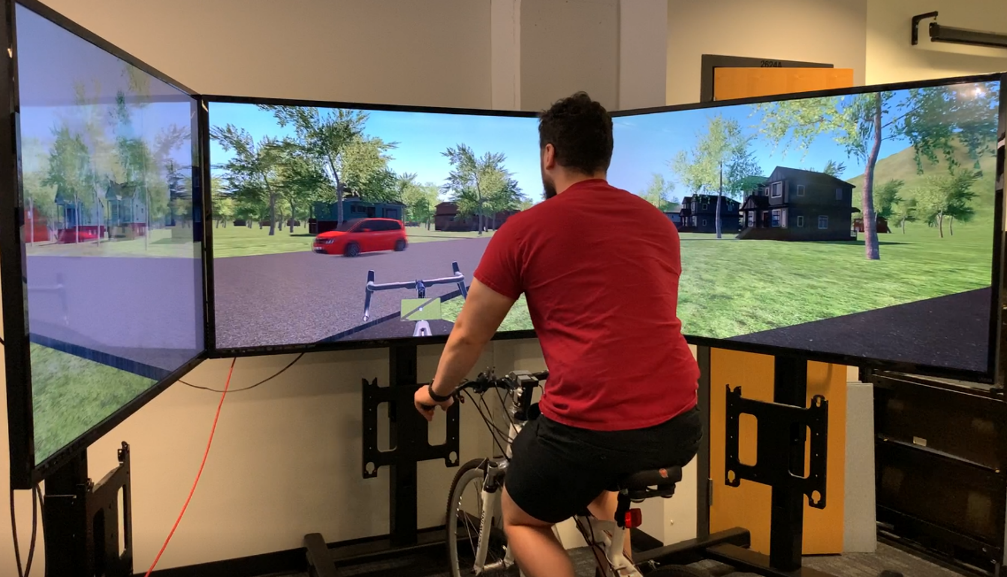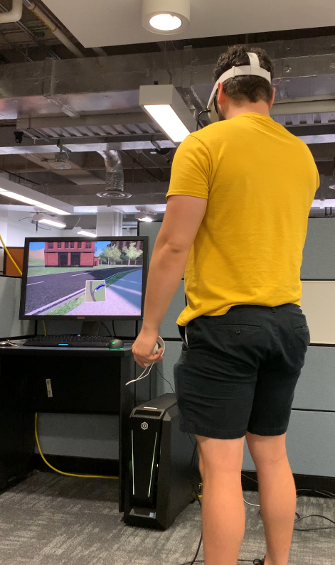With over 5.25 million traffic incidents being reported in 2020 alone, improving safety in road design is essential. A research team at the VRAC comprised of graduate students Jack Miller, Adam Kohl, Michael Holm, Jacklin Stonewall, Jordan Williams, and Tor Finseth and faculty members Vijay Kalivarapu, Michael Dorneich, Stephen Gilbert, Anuj Sharma, and Eliot Winer developed a multi-user traffic simulation platform capable of generating and rendering life-like roadways and traffic scenarios on various hardware devices. The outcomes of this project enable traffic safety researchers to study complex traffic environments and new situations such as bike friendly cities and adoption of autonomous vehicles.
“By utilizing virtual environments to study a variety of traffic scenarios, valuable data can be collected to better understand the complex interactions between drivers, bicyclists, and pedestrians.”
Traffic simulation has been a focus of research for many decades to better understand the flow of vehicles and human behavior in various environments. The outcomes of most of these projects and products are limited in their simulation capabilities. Further, the creation of virtual environments requires expertise in computer graphics and 3D modeling that traffic researchers are unlikely to possess. The research challenges in this project seek to remedy these issues by developing a multi-modal multi-user traffic simulation platform accessible to a wide variety of traffic researchers, named IntrchangeSE.
InterchangeSE enables widespread traffic research by providing a simulation platform using commodity devices and software, ensuring a high level of accessibility. The modes include a vehicle, bicycle, and pedestrian setup that allows interfacing with any developed roadway design. Through this setup and interface, traffic researchers can study a variety of scenarios with factors such as different human agents, environments, traffic density, and weather conditions. Additionally, to enable traffic researchers to explore a limitless number of scenarios, the process to create large 3D traffic environments was streamlined through state-of-the-art image processing and computer graphics techniques.


The architecture of InterchangeSE provides an interface to communicate between vehicle simulators, bicycle simulators, pedestrian simulators, and a commercial traffic simulator to simulate traffic and generate virtual vehicles. A user can interact with the environment through extended reality (XR) head-mounted displays or multi-monitor displays depending on the researchers access to hardware or intended use case. Additionally, low-cost physical human interfaces were also developed to enhance the immersion of the various simulators. Lastly, a viewer was developed, giving the researcher control over the simulation such as time of day, weather, user routes, and a bird’s eye view of the environment in real time.
The second key outcome of this research was optimizing and streamlining the authoring process of large-scale scenarios for use in traffic behavior research. This process allows for creating customizable roadway designs (e.g., highway off-ramp, residential streets) without expertise in 3D modeling software. These capabilities were accomplished using state-of-the-art image processing to identify major traffic-related entities within 2D images, from Google Earth or other GIS software, followed by the generation of that environment in 3D using computer graphics and vision techniques.
Using industry-standard traffic simulation, commodity hardware, computer graphics, and image processing, InterchangeSE can be used to accurately simulate limitless traffic scenarios in a controlled setting with human agents.
Publications
Miller, J., Kalivarapu, V., Holm, M., Winer, E., Dorneich, MC., & Gilbert, S. (2023). A Distributed Multi-Modal Traffic Simulation Platform to Study Traffic Behavior. Submitted to Journal of Future Generation Computer Systems.
Stonwall, J., Dorneich, MC., Winer, E., Miller, J., Kalivarapu, V., Kohl, A., Gilbert, S., & Sharma, A. (2022). A Federated Multimodal Simulation Environment for Studying Interactions between Different Modes of Travel. Proceedings of I/ITSEC.
Kalivarapu, V., Kohl, A., Miller, J., Winer, E. (2020). Desigining a Deep Learning Computer-Vision Based Autonomous Vehicle Within a Multimodal Traffic Simulation Framework. Proceedings of I/ITSEC.
Miller, J., Kalivarapu, V., Holm, M., Finseth, T., Williams, J., & Winer, E. (2020). A Flexible Multi-Modal Multi-User Traffic Simulation for Studying Complex Road Design. Proceedings of ASME IDETC-CIE